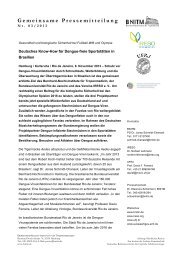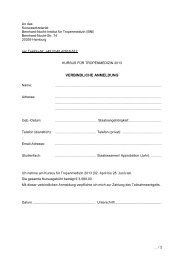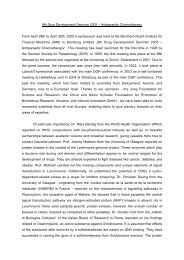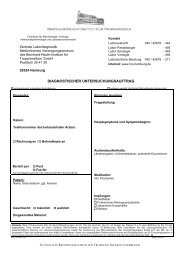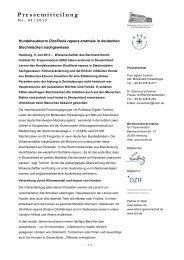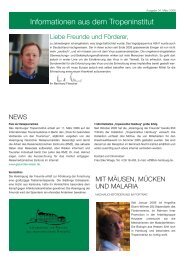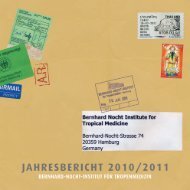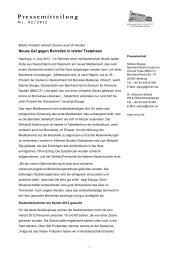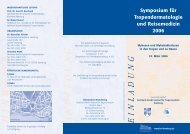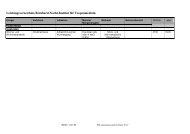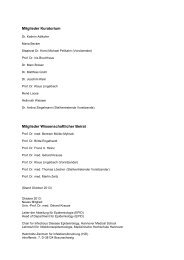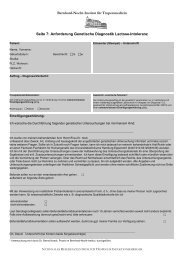Research Group Heussler (Malaria I) - Bernhard-Nocht-Institut für ...
Research Group Heussler (Malaria I) - Bernhard-Nocht-Institut für ...
Research Group Heussler (Malaria I) - Bernhard-Nocht-Institut für ...
You also want an ePaper? Increase the reach of your titles
YUMPU automatically turns print PDFs into web optimized ePapers that Google loves.
Tropical Medicine Section<br />
Human genetic variants influencing<br />
resistance to malaria<br />
Zusammenfassung<br />
Um neue Methoden der Prävention und Bekämpfung<br />
der <strong>Malaria</strong> zu entwickeln, wird untersucht,<br />
wie Menschen natürlicherweise vor <strong>Malaria</strong><br />
geschützt sein können. Aufgrund ihrer hohen Kindersterblichkeit<br />
hat <strong>Malaria</strong> die Selektion zahlreicher<br />
genetischer Anlagen des Menschen bewirkt, die<br />
eine gewisse Resistenz oder Protektion vor <strong>Malaria</strong><br />
vermitteln. Die Aufklärung dieser Faktoren könnte<br />
auf Stoffwechselwege hinweisen, die vor <strong>Malaria</strong>-<br />
Parasitämie und klinischer Erkrankung schützen.<br />
In einem Endemiegebiet der <strong>Malaria</strong> in Ghana<br />
wurden 120 Familien ausgewählt, die keine der<br />
möglicherweise schützenden Erythrozyten-Anomalien<br />
zeigen. Aus diesen Familien wurden über 450<br />
Geschwisterkinder über 8 Monate wöchentlich auf<br />
<strong>Malaria</strong>parasiten und klinische Zeichen einer <strong>Malaria</strong><br />
untersucht. Derzeit wird eine Kopplungsanalyse<br />
durchgeführt, um neue genetische Resistenzfaktoren<br />
zu suchen. Darüber hinaus wurden über 2000 Fälle<br />
von komplizierter <strong>Malaria</strong> und entsprechende<br />
Kontrollpersonen untersucht und in eine Studie<br />
aufgenommen, die das Ziel hat, genetische Faktoren<br />
zu identifizieren, die vor komplizierter <strong>Malaria</strong><br />
schützen. In Anbetracht der enormen Bedeutung<br />
der Medikamentenresistenz von <strong>Malaria</strong>parasiten<br />
und ihres möglichen Einflusses auf das klinische Bild<br />
der <strong>Malaria</strong> wurde ein neuer massenspektrometrischer<br />
Test entwickelt, der die Sensitivität der<br />
Identifizierung medikamentenresistenter Isolate bei<br />
multiplen Infektionen deutlich verbessert.<br />
Summary<br />
Naturally occurring mechanisms of resistance and<br />
protection are being studied in order to develop novel<br />
means of prevention and control. It is generally accepted<br />
that malaria, particulary becaue of its high childhood<br />
mortality, has selected for many, as yet unknown<br />
human genetic traits. These might indicate metabolic<br />
pathways which protect against parasitaemia and clinical<br />
disease. Thus, 120 families were selected not to carry<br />
any of the possibly protective red-cell disorders. Of<br />
those, more than 450 siblings were closely monitored<br />
for parasitaemia and mild malaria over a period of 8<br />
months. Presently, a linkage analysis is being performed<br />
to search for novel genetic resistance factors.<br />
In addition, more than 2000 cases of severe and complicated<br />
malaria have been examined and included in a<br />
study aiming at genetic factors which protect from severe<br />
disease. With regard to the enormous importance<br />
of drug-resistant malaria and its possible influence on<br />
clinical disease presentation, a new mass-spectrometry<br />
assay was developed which substantially increases the<br />
80<br />
sensitivity of identifying drug-resistant isolates in<br />
multiple infections.<br />
Introduction<br />
Drawbacks in vaccine development and problems of<br />
drug resistance have stressed the demand for research<br />
on fundamental issues in plasmodium biology and<br />
malaria pathology. One approach to identify possible<br />
routes of prevention and control is to unravel naturally<br />
occurring mechanisms of resistance and protection.<br />
Protection against severe malaria has clearly been<br />
shown to be mediated by certain red-cell disorders and<br />
by genetic variants of several immune response and<br />
effector molecules. It is generally accepted that malaria<br />
has in exposed populations selected for many more<br />
human genetic traits.<br />
Project Description and Results<br />
Phenotyping for parasitaemia and mild malaria<br />
In holoendemic malaria areas such as our study sites in<br />
the vicinity of Kumasi, Ghana, all residents are exposed<br />
to malaria transmission. Therefore, virtually all children<br />
for various periods of time and to various degrees carry<br />
malaria parasites in their blood while they develop<br />
partial immunity. Occasionally and, again with considerable<br />
inter-individual variability, these parasitaemias<br />
cause mild clinical disease and, rarely and in 1-2% of<br />
children only, severe and complicated malaria (see<br />
below). Since parasitaemias and mild clinical malaria<br />
episodes affect virtually all children and thus all siblings<br />
of a given family, they are accessible to a genetic linkage<br />
study using a quantitative-trait analysis. For this<br />
approach, 2600 parental pairs who have more than 3<br />
children aged 0.5 to 11 years were genetically examined<br />
not to carry any of the known or assumed red-cell<br />
malaria resistance factors of haemoglobin (Hb)S and C,<br />
a-thalassaemia and glucose-6-phosphate dehydrogenase<br />
deficiency A-. 120 families were identified, and the<br />
children (450 forming 650 sib-pairs) were thoroughly<br />
phenotyped for malaria parasitaemias and mild disease<br />
over an entire rainy season by weekly visits including interrogations<br />
and malaria smears and biweekly haematocrits.<br />
The phenotyping procedure required more than<br />
14,000 home visits, whereby the compliance was >99%.<br />
Phenotype data are presently being evaluated, first<br />
results confirm the current concept of the acquisition of<br />
partial malaria immunity during childhood (Fig.1), at the<br />
same time showing the quality of the phenotype data.<br />
Interestingly, 1-2% of children never had parasitaemias.<br />
At present, the children are being genotyped at 10,000<br />
genome-wide single-nucleotide polymorphisms applying<br />
microarrays at the DNA-typing centre of the National<br />
Genome <strong>Research</strong> Network (NGFN).



